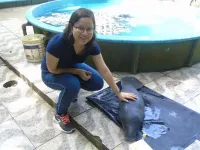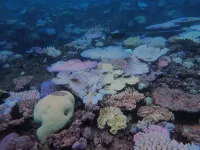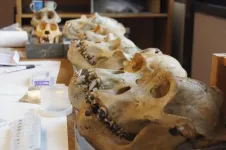(Press-News.org) All three species of manatee now present on Earth share a common ancestor from which they split some 6.5 million years ago, when a huge lake in Amazonia, then linked to the Caribbean, was cut off from the sea. The African manatee Trichechus senegalensis is not as genetically close to the West Indian manatee T. manatus as was thought, and adaptation to this complex environment by the Amazonian manatee T. inunguis has left at least one mark in its genetic code.
These are key findings of a study supported by FAPESP and published in Scientific Reports, with hitherto unknown details of the evolutionary history of these aquatic mammals. The authors are an international group of scientists led by researchers at the University of Campinas (UNICAMP) in the state of São Paulo, Brazil. They achieved the first sequencing of the mitochondrial DNA of all three manatee species.
"About 20 million years ago, Amazonia was connected to the Caribbean by Lake Pebas, a mega-wetland that has since disappeared. Manatees inhabited both Amazonia and the Caribbean - not the extant species but a common ancestor. Some 9 million years ago, the sea level fell, and Pebas shrank and became disconnected from the Caribbean. The manatees in Amazonia became semi-isolated. There was a sea inlet into the lake, but between 6 million and 5 million years ago Amazonia was totally cut off from the Caribbean. The populations became separate and began specializing in either a river or marine environment," said Mariana Freitas Nery, principal investigator for the study. Nery is a professor at UNICAMP's Institute of Biology and has a Young Investigator Grant from FAPESP.
There are few fossil records of manatees, but the researchers were able to reconstruct the evolutionary history of Trichechus by cross-referencing the existing information with geological and genetic data. Tissue samples were obtained via collaboration with researchers at the Mamirauá Institute of Sustainable Development in Amazonas, the Federal University of Minas Gerais (UFMG), and institutions in Belgium and the United States.
Mitochondrial DNA (inherited from the mother) contains fewer genes than nuclear DNA but is easier to sequence in the laboratory and provides crucial information on the evolution of any living being. "We were able to add information not found in the studies performed to date, especially on the African manatee. Existing phylogenies referred only to the species found in the Americas and even so only for some genes. It has always been hard to get access to material from T. senegalensis, but we succeeded thanks to this international collaboration. We ended up with a well-founded hypothesis on the distribution of these aquatic mammals," Érica Martinha Silva de Souza, first author of the article, told Agência FAPESP. The study was part of her doctoral research at UNICAMP.
From South America to Africa
"It's very interesting to see how the history of the Amazon Basin influenced the distribution of several fish, bird, reptile and mammal species. Our study shows clearly the influence of the formation of the Amazon Basin on the distribution of manatees," Souza said.
In January 2021, while the authors were finishing the article, it was announced that the first fossils of a fourth member of the group, the extinct Western Amazon manatee Trichechus hesperamazonicus, had been dated. Fragments of the mandibles and palate found in what is now Rondônia state, Brazil, were dated to 45,000 years ago. No manatees have ever been sighted in the area.
According to the UNICAMP researchers, if fossils were found in Africa they would be of great help in establishing when manatees arrived on the continent, probably via sea currents.
Studies conducted by other groups, in which the morphologies of the different species were compared and some genes were analyzed, found that the African manatee T. senegalensis, which inhabits the coastal waters between Senegal and northern Angola, as well as the rivers that flow into them, is closest to T. manatus, found in an area between the southeast coast of the US, the Caribbean and Northeast Brazil.
The mitochondrial DNA analyzed by the UNICAMP group showed that T. manatus is actually a closer relative of T. inunguis than of T. senegalensis. The links between T. senegalensis and T. manatus observed in other studies are probably due to characteristics of their habitats.
Manatees feed on bottom-growing aquatic plants, and this explains the shape of their jaws and teeth. They can move comfortably between freshwater, sea water, and the brackish water of estuaries, although T. inunguis prefers freshwater. This flexibility is signaled by a mutation in ND4, a gene associated with the cellular respiratory chain. The same mutation has been detected in river dolphins, subterranean mammals and alpacas inhabiting high altitudes. Other studies have also shown that the mutation may be linked to changes in temperature in the environment and adaptations required to suit a low-energy diet to the needs of a large body, all of which applies to T. inunguis, the Amazonian species.
"We found what we call positive selection in this gene specific to the cellular respiratory chain," Nery said. "The freshwater environment is complex and dynamic, with variations in temperature, sediment and acidity, especially in the Amazon Basin, so it was expected that the species would display more molecular 'footprints' of adaptation to this environment."
All three species have been intensely hunted because they are docile and relatively unafraid of humans. Moreover, their habitats are under constant threat. As a result, they are classed as vulnerable by the International Union for Conservation of Nature (IUCN). Detailed knowledge is key to their conservation.
For this reason, the UNICAMP researchers support groups that are working on conservation. They are currently sequencing the whole nuclear genome of the manatees found in Brazil. "From the standpoint of evolutionary history, I don't expect this sequencing to change much compared with what we've already found in the mitochondrial genome, but we're looking for fresh information that will help us understand these animals more fully. So far we've written the most complete history possible," Nery said.
INFORMATION:
About São Paulo Research Foundation (FAPESP)
The São Paulo Research Foundation (FAPESP) is a public institution with the mission of supporting scientific research in all fields of knowledge by awarding scholarships, fellowships and grants to investigators linked with higher education and research institutions in the State of São Paulo, Brazil. FAPESP is aware that the very best research can only be done by working with the best researchers internationally. Therefore, it has established partnerships with funding agencies, higher education, private companies, and research organizations in other countries known for the quality of their research and has been encouraging scientists funded by its grants to further develop their international collaboration. You can learn more about FAPESP at http://www.fapesp.br/en and visit FAPESP news agency at http://www.agencia.fapesp.br/en to keep updated with the latest scientific breakthroughs FAPESP helps achieve through its many programs, awards and research centers. You may also subscribe to FAPESP news agency at http://agencia.fapesp.br/subscribe.
The American College of Chest Physicians® (CHEST) recently released new clinical guidelines on the Diagnosis and Evaluation of Hypersensitivity Pneumonitis (HP). The guidelines contain 14 evidence-based recommendations to improve individual diagnostic decision-making and to decrease diagnostic practice variability.
Occurring at any age, HP is an immunologically mediated form of lung disease resulting from inhalational exposure to a large variety of environmental and/or occupational inciting antigens (typically fungal, bacterial, avian). Over the years, the categorization of HP based on clinical features and disease duration coupled with traditional diagnostic criteria has been unhelpful, even when accurate, when separated from a probabilistic diagnostic ...
Clavelina oblonga, an invasive marine fouling species, not only reduces diversity in communities it invades, it also interferes in their recovery following natural disasters - a process known as "succession."
Succession refers to how an ecosystem recovers after a disturbance or natural disaster - does the system come back more or less the same as it was in terms of species composition, or is it different?
"The classic example of succession is a forest that experiences a wildfire," says Kayla Christianson, former NC State graduate student and first author of a paper describing the research. "As the community recovers from the fire, it proceeds through a predictable pattern of community development - starting with grasses and ending with trees and a mature forest. This ...
Since it debuted in 2011, the Get SET Early program, which provides pediatricians and parents with a relatively simple process to screen for indicators of autism spectrum disorder (ASD) in children as young as age 1, has steadily grown in use and validation. Early screening and identification of ASD has been linked to more effective treatment.
A new study, published in the April 26, 2021 issue of the END ...
PHILADELPHIA-- Human brain organoids are remarkable platforms for modeling features of human brain development and diseases. Building on methods to generate organoids to model different brain regions such as the cortex and the midbrain, researchers at the Perelman School of Medicine at the University of Pennsylvania have generated the first organoids of the arcuate nucleus (ARC), an essential structure in the hypothalamus that sends signals of hunger and feeling full. This part of the hypothalamus exhibits a tremendous amount of cell diversity, and is far more complex than previously modeled parts of the brain.
In a paper ...
Scientists have made major advances in understanding and developing treatments for many cancers by identifying genetic mutations that drive the disease. Now a team led by researchers at Weill Cornell Medicine, NewYork-Presbyterian and the New York Genome Center (NYGC) has developed a machine learning technique for detecting other modifications to DNA that have a similar effect.
The study, published May 10 in Cancer Discovery, a journal of the American Association for Cancer Research, focuses on a type of chemical modification to DNA, called methylation, that typically silences nearby genes. The new technique can analyze the thousands of DNA methylation changes detected in tumor cells and infer which ones are likely ...
HOUSTON - Researchers at The University of Texas MD Anderson Cancer Center have developed a first-of-its-kind spatial atlas of early-stage lung cancer and surrounding normal lung tissue at single-cell resolution, providing a valuable resource for studying tumor development and identifying new therapeutic targets. The study was published today in Cancer Discovery, a journal of the American Association for Cancer Research.
The findings reveal a heterogeneous lung cancer ecosystem, with extensive interactions between cancer cells and the surrounding microenvironment that regulate early cancer development. ...
New research on the growth rates of coral reefs shows there is still a window of opportunity to save the world's coral reefs--but time is running out.
The international study was initiated at the ARC Centre of Excellence for Coral Reef Studies (Coral CoE), which is headquartered at James Cook University (JCU).
Co-author Professor Morgan Pratchett from Coral CoE at JCU said the results show that unless carbon dioxide emissions are drastically reduced the growth of coral reefs will be stunted.
"The threat posed by climate change to coral reefs is already very apparent based on recurrent episodes of mass coral bleaching," Prof Pratchett said. "But changing environmental conditions will have other far-reaching consequences."
Co-author Professor Ryan Lowe, from Coral CoE at The University ...
A new study looking at the evolutionary history of the human oral microbiome shows that Neanderthals and ancient humans adapted to eating starch-rich foods as far back as 100,000 years ago, which is much earlier than previously thought.
The findings suggest such foods became important in the human diet well before the introduction of farming and even before the evolution of modern humans. And while these early humans probably didn't realize it, the benefits of bringing the foods into their diet likely helped pave the way for the expansion of the human brain because of the glucose in starch, which is the brain's main fuel source.
"We think we're seeing evidence of a really ...
ORLANDO, May 10, 2021 -University of Central Florida researchers are building on their technology that could pave the way for hypersonic flight, such as travel from New York to Los Angeles in under 30 minutes.
In their latest research published in the journal Proceedings of the National Academy of Sciences, the researchers discovered a way to stabilize the detonation needed for hypersonic propulsion by creating a special hypersonic reaction chamber for jet engines.
"There is an intensifying international effort to develop robust propulsion systems for hypersonic and supersonic flight that would allow flight through our atmosphere at very high speeds and also allow efficient entry and exit from planetary atmospheres," ...
In a newly published paper, Virginia Tech geoscientists have found that shallow wastewater injection -- not deep wastewater injections -- can drive widespread deep earthquake activity in unconventional oil and gas production fields.
Brine is a toxic wastewater byproduct of oil and gas production. Well drillers dispose of large quantities of brine by injecting it into subsurface formations, where its injection can cause earthquakes, according to Guang Zhai, a postdoctoral research scientist in the Department of Geosciences, part of the Virginia Tech College of Science, and a ...





